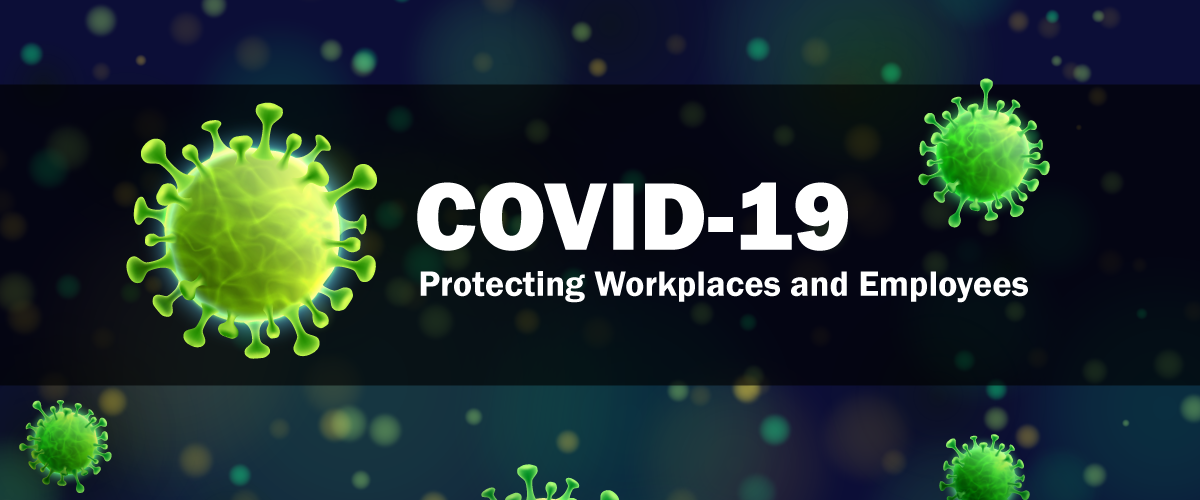
COVID-19: Protecting Workplaces and Employees
PA Training for Health & Safety Accident Prevention Through Education
Purpose
To provide guidance for businesses and employers on how to plan for and respond to Coronavirus Disease 2019 (COVID-19). This guidance is based on what is currently known about the coronavirus disease 2019 (COVID-19). COVID-19 is a respiratory illness that can spread from person to person. The outbreak first started in China, but the virus continues to spread internationally and in the United States. The following guidance is meant to help prevent workplace exposures to COVID-19, in non-healthcare settings.
Reference: https://www.cdc.gov/coronavirus/2019-ncov/index.html
Preparing Workplaces for a COVID-19 Outbreak
![]()
Businesses and employers can prevent as well as slow the spread of COVID-19. Employers should plan to respond in a flexible way to varying levels of disease transmission in the community and be prepared to refine their business response plans as needed. According to the Occupational Safety and Health Administration (OSHA), most American workers will likely experience low (caution) or medium exposure risk levels at their job or place of employment. Reference: OSHA guidance for employers for more information about job risk classifications.
Businesses are strongly encouraged to enforce the mitigation strategy disseminated by the governor and the Pennsylvania Department of Health to help lessen the impact of COVID-19.
All employers need to consider how best to decrease the spread of COVID-19 and lower the impact in their workplace
This should include the following areas:
- Cleaning AND disinfecting frequently touched objects and surfaces such as workstations, keyboards, telephones, handrails, and doorknobs. Dirty surfaces can be cleaned with soap and water prior to disinfection. To disinfect, use products that meet EPA’s criteria for use against, the cause of COVID-19, and are appropriate for the surface
- Provide disposable wipes so that commonly used surfaces (for example, doorknobs, keyboards, remote controls, desks, other work tools, and equipment) can be wiped down by employees before each use to help reduce transmission among employees
Reference: https://www.cdc.gov/coronavirus/2019-ncov/community/guidance-business-response.html
What can employees do to reduce the spread of COVID-19
- Employees can take steps to protect themselves at work and at home. Older employees and people with serious chronic medical conditions are at higher risk for complications.
- Stay home if you are sick, except to get medical care. Learn what to do if you are sick
- Inform your supervisor if you have a sick family member at home with COVID-19
- Learn what to do if someone in your house is sick
- Wash your hands often with soap and water for at least 20 seconds. Use hand sanitizer with at least 60% alcohol if soap and water are not available
- Avoid touching your eyes, nose, and mouth with unwashed hands
- Cover your mouth and nose with a tissue when you cough or sneeze or use the inside of your elbow. Throw used tissues in the trash and immediately wash hands with soap and water for at least 20 seconds. If soap and water are not available, use a hand sanitizer containing at least 60% alcohol. Learn more about coughing and sneezing etiquette on the PA Department of Health website.
- Avoid using other employees’ phones, desks, offices, or other work tools and equipment, when possible. If necessary, clean and disinfect them before and after use
- Follow the policies and procedures of your employer-related to illness, cleaning and disinfecting, and work meetings and travel
Reference: https://www.cdc.gov/coronavirus/2019-ncov/community/guidance-business-response.html
Employers should enforce policies and practices for social distancing
Social distancing should be enforced. Social distancing means maintaining distance (approximately 6 feet or 2 meters) from others when possible (e.g., breakrooms and cafeterias).
It is critical to emphasize that maintaining 6-feet social distancing remains important to slow the spread of the virus. American College of Occupational and Environmental Medicine (ACOEM) encourages the use of face coverings in the workplace where respirators have not historically been required to help prevent people who may have the virus and do not know it from transmitting it to others. Strategies that business could use include:
- Implementing flexible worksites (e.g., telework)
- Implementing flexible work hours (e.g., staggered shifts)
- Increasing physical space between employees at the worksite
- Increasing physical space between employees and customers (e.g., drive through, partitions)
- Implementing flexible meeting and travel options (e.g., postpone non-essential meetings or events)
- Downsizing operations
- Delivering services remotely (e.g. phone, video, or web)
- Delivering products through curbside pick-up or delivery
Reference: https://www.cdc.gov/coronavirus/2019-ncov/community/guidance-business-response.html
Assess your essential business functions and the reliance the community has on your services or products
- Change your business practices to maintain critical operations (e.g., identify alternative suppliers, prioritize existing customers, or curbside pickup)
- Talk with companies that provide your business with a contract or temporary employees about the importance of sick employees staying home and encourage them to develop non-punitive leave policies
- Talk with business partners about your response plans. Share best practices with other businesses in your communities (especially those in your supply chain), chambers of commerce, and associations to improve community response efforts
Reference: https://www.cdc.gov/coronavirus/2019-ncov/community/guidance-business-response.html
Determine how you will operate if absenteeism spikes from increases in sick employees, and those who stay home to care for sick family members
- Plan to monitor and respond to absenteeism at the workplace
- Implement plans to continue your essential business functions in case you experience higher than usual absenteeism
- Prepare to institute flexible workplace and leave policies
- Cross-train employees to perform essential functions so the workplace can operate even if key employees are absent
Separate sick employees
- Employees who appear to have symptoms (i.e., fever, cough, or shortness of breath) upon arrival at work or who become sick during the day should immediately be separated from other employees, customers, and visitors and sent home
- If an employee is confirmed to have COVID-19 infection, employers should inform fellow employees of their possible exposure to COVID-19 in the workplace but maintain confidentiality as required by the Americans with Disabilities Act (ADA). The employer should instruct fellow employees about how to proceed based on the CDC Public Health Recommendations for Community-Related Exposure.
Reference: https://www.cdc.gov/coronavirus/2019-ncov/community/guidance-business-response.html
COVID-19: Phased-In Process for Restarting Construction Projects
Resources for more information:
CDC Guidance
- COVID-19 Website
- What You Need to Know About COVID-19
- What to Do If You Are Sick With COVID-19
- Interim US Guidance for Risk Assessment and Public Health Management of Persons with Potential Coronavirus Disease 2019 (COVID-19) Exposure in Travel-associated or Community Settings
- Health Alert Network
- Travelers’ Health Website
- National Institute for Occupational Safety and Health’s Small Business International Travel Resource Travel Planner
- Coronavirus Disease 2019 Recommendations for Ships
- Coronavirus Disease 2019 Recommendations for Airlines and Airline crew
- Persons at Higher Risk of Severe Illness
- When and How to Wash Your Hands
Other Agencies and Partners
Additional Resources
- World Health Organization updates on COVID-19
- CDC Questions & Answers COVID-19
